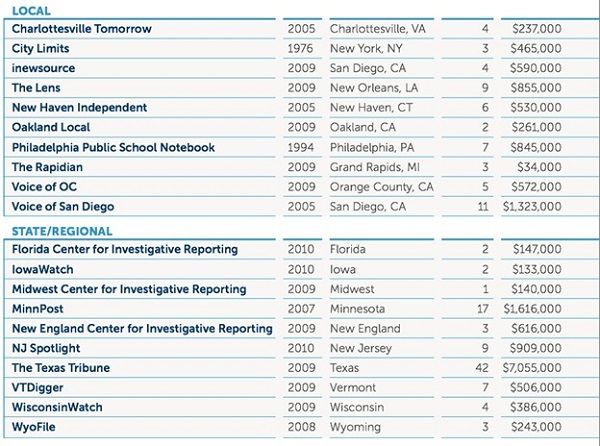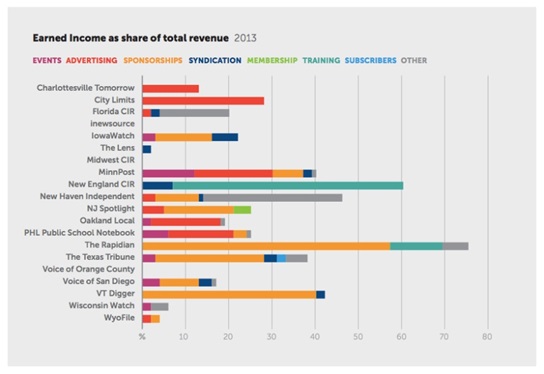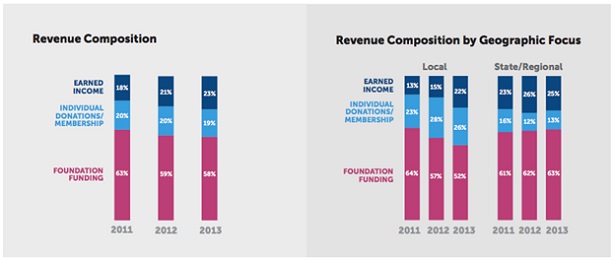
NPQ has recently wandered over some of the ground covered by the latest report by the John S. and James L. Knight Foundation, Gaining Ground: How Nonprofit News Ventures Seek Sustainability, in a number of ways. First, we took up some of the findings in our recent journal article, “A Field of Toddlers: Nonprofit News Sites.” Secondly, NPQ is, of course, a part of that field, though not one of the groups supported by or studied by Knight, and our perspective makes us particularly familiar with what is being discussed.
I am personally familiar with what it takes to make a news site financially sustainable, and I can state with some authority that I have not got what it takes. For that, NPQ had to hire a publisher who, even with an extensive track record in similar endeavors, has had to experiment and poke and prod our revenue streams (or trickles) until they began to flow.
This brings me to my point: Without a sufficiently big (for us) dose of capital to allow NPQ to hire a publisher and provide him with the tools and running room he needed, we would not have had a chance to turn the corner we knew was there but could not reach. In other words, NPQ had access to “patient” capital—multi-year and dependent upon a sound business plan. The plan alone was insufficient; capital by itself would have been insufficient, too. Both together were hard won and created a window that we have to get through before it closes.
The 20 news sites that Knight tracked for this 2011–2013 report are local, statewide, or regional. Their focuses differ: a few are political junkie hangouts, some concentrate on local news and information, and some are heavy-duty investigative. Their budgets range from $34,000 to more than $7 million.
So, what can we learn from such a diverse field? A lot. Here are the groups that were studied, broken up into two groups—statewide or regional, and local—so readers can get a sense of budget size:

Once we look at the budgets, we have to look at how they are composed. I was particularly taken with the graphs on earned revenue composition, because the mix for each group is so individual and because that, along with donations, is what will provide most of the groups with sustainability, since it is often unwise to count on the constancy of foundations over time.

All of these revenue streams are familiar in that other outlets, whether nonprofit or for-profit, also use them, and there is actually a lot of information around about how to make them work. But—and here is the sticking point—each organization has to figure out what will work in their particular niche with their particular readers, and then they must build (and rebuild) transaction mechanisms and technological capacity to keep everything organized and able to deliver to expectations, which means ever more seamlessly. That may be a heavy lift for an organization with a budget between $100,000 and $500,000, especially one that has editorial deadlines to meet if it is to be taken at all seriously and if it is to become a hard-to-put-down habit for readers. The readers’ dedicated presence is, of course, what both your financial sustainability and your impact are usually built on.
In the end, the whole financial house of cards is built upon the need for sufficient patient capital to, over time, systematically test many ideas, discard some, and build the most promising revenue-producing systems while on a rigorous editorial schedule.
Sign up for our free newsletters
Subscribe to NPQ's newsletters to have our top stories delivered directly to your inbox.
By signing up, you agree to our privacy policy and terms of use, and to receive messages from NPQ and our partners.
And that capital is usually applied from operating grants, which are, for many of these groups, iffy to say the least, although dependence on them continues to be high. Grant funding accounts for 58 percent of revenue for these groups across the board, but small local groups tend to get less of it, and it constitutes a lower proportion of their budgets in relation to earned and donated income.

The report finds that state and regional sites grew their foundation funding by 98 percent while local sites saw an eight percent decline. What philanthropic support there is for those smaller organizations is often used to support editorial because…well, there really isn’t a lot to work with, and thus a starvation cycle ensues. The report finds that as budgets grow to a greater than starvation level, the groups do invest in technology and marketing. Hmmm.
Though average revenue among the 20 sites increased by 73 percent between 2011 and 2013, it is no surprise that these revenue gains were driven by a few sites, including the well-capitalized Texas Tribune, which gained $3 million in annual revenue over the period. This makes the smaller end of the field, largely local groups, a geographically-dispersed monument to tenacious civic persistence.
The study found that groups with well-formed business plans grew at a faster rate than the others. Perhaps it would be wise for local foundations to get organized and consider getting in and supporting the development of business plans—while also, of course, providing higher-level multi-year grants to carry them out.
And here is a clue: When a field is in development such that revenue generation is still very experimental even for well-capitalized groups, you have to assume that business plans will change after each group’s failures and successes and that the whole enterprise will take longer to solidify. If the executives of these groups have posited shorter timelines for sustainability than come to fruition, they may not be bad managers—just hopeful, inadequately capitalized, and impossibly pressed managers.
Knight has, as I mentioned in my prior article, done the right thing in not only analyzing the field’s financial patterns but in supporting infrastructure in the form of the Institute for Nonprofit News (formerly the Investigative News Network). But local foundations must understand the long horizons on the establishment of these valuable civic newcomers to help the local nonprofit news field move toward maturity.











